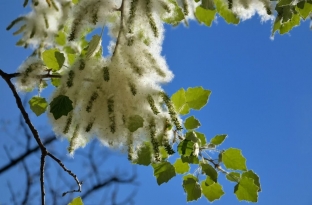It is generally accepted that allergy to poplar fluff – a fairly common occurrence. In fact, the fluff of this plant very rarely leads to negative reactions in our immune system. And the manifestation of unpleasant sensations, as a rule, is associated with the flowering of other plants. Therefore, in practice, the opinion that poplar fluff causes allergies is erroneous and by and large – myth. Details about the problem, about what happens in the body during such periods, what should be the measures to prevent the development of strong reactions, will tell estet-portal.com.
Allergy to poplar fluff: what actually causes the reaction
The fluff of this particular tree is not so often the cause of any reactions, because it is a fairly large particle. However, it spreads spores and pollen from other plants, which leads to allergies. So, at the same time as poplar, birch also blooms, and this is just a very strong allergen. The reaction is possible to most other herbs and plants, in particular, to cereals and meadows.
Symptoms of the disease (as a rule, these are respiratory reactions: lacrimation, sore throat, runny nose) begin to appear when flowering products enter the respiratory tract.
In addition, the following manifestations of hypersensitivity to poplar fluff should not be overlooked:
- rapid heart rate;
- paroxysmal sneezing;
- inflamed and reddened eyelids;
- breathing problems;
- swelling of mucous membranes;
- nausea and dizziness;
- cold sweat.
If the case is particularly serious, an allergy to poplar fluff in the last month of spring can lead to the development of suffocation, anaphylactic shock, and seizures.
The danger is this: having appeared once, the above symptoms are evidence that hay fever will accompany a person throughout his life. Therefore, it is very important to consult a doctor in time, who will prescribe an effective treatment.

Allergy to poplar fluff: important rules for solving the problem
In order to avoid serious consequences and complications, people with allergies are required to observe the following rules:
- First of all, you need to make sure that the symptoms you are experiencing are – allergy to poplar fluff. If runny nose, inflammation of the mucous membrane of the eyes and cough accompany you all the spring months, this most likely indicates reactions to a wide variety of plants. The necessary blood test in this case will certainly establish the truth.
- During the poplar flowering period, it is required to frequently wet clean the room and use humidifiers: when using the latter, the air is sufficiently cleaned of allergens due to the fact that pollen settles on the floor.
- During the flowering period of plants that pose an allergenic danger, experts recommend frequent showering procedures: this helps to wash harmful pollen from the body and hair. Also important is the systematic washing of the nasopharynx, for which at home you can prepare a regular salt solution: take 0.5 tsp. salt and dissolve in water (250 ml).
- The ideal and, frankly, the cardinal solution to the problem of allergy to poplar fluff is a trip to places where poplars are not found and there are no other sources of allergy (and these are, as a rule, mountainous areas or northern regions; a great alternative – from - due to high humidity, which reduces the likelihood of pollinosis – and the sea coast).
According to estet-portal.com, allergic reactions to poplar fluff are quite rare, and often the flowering product of this tree only tolerates allergens. Nevertheless, if symptoms characteristic of hay fever appear, contact a specialist without delay to avoid complications of pathology.






Add a comment